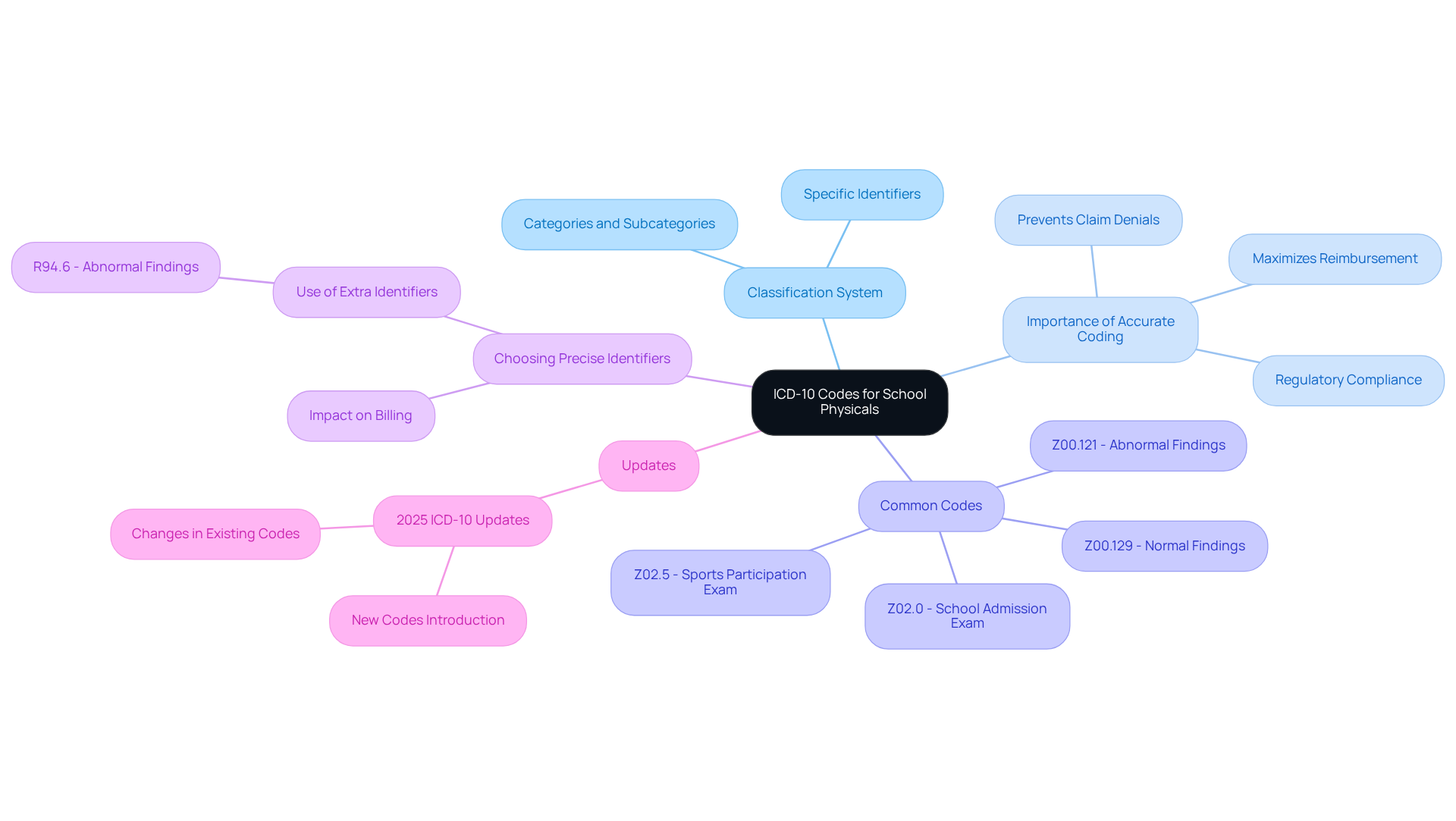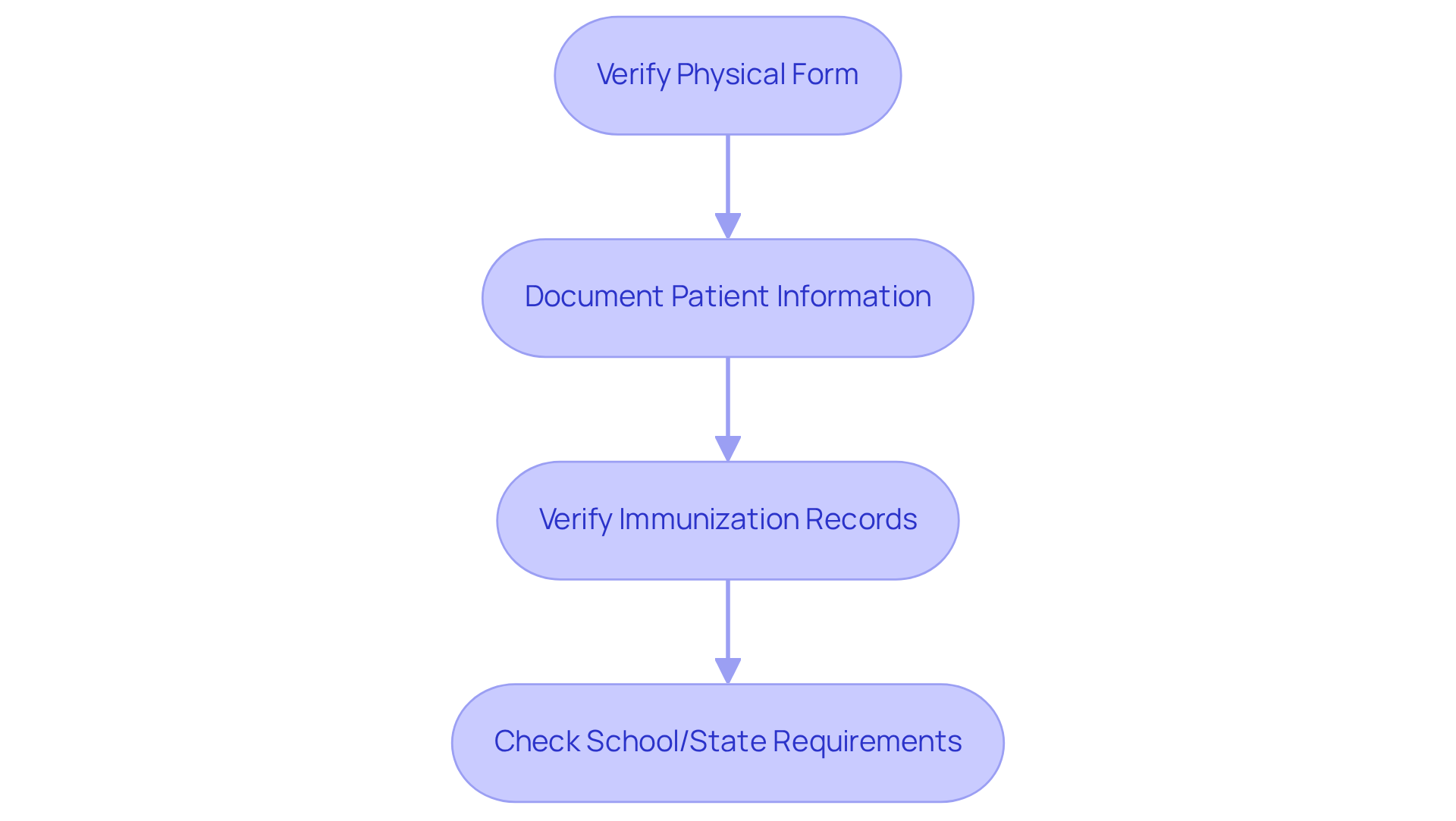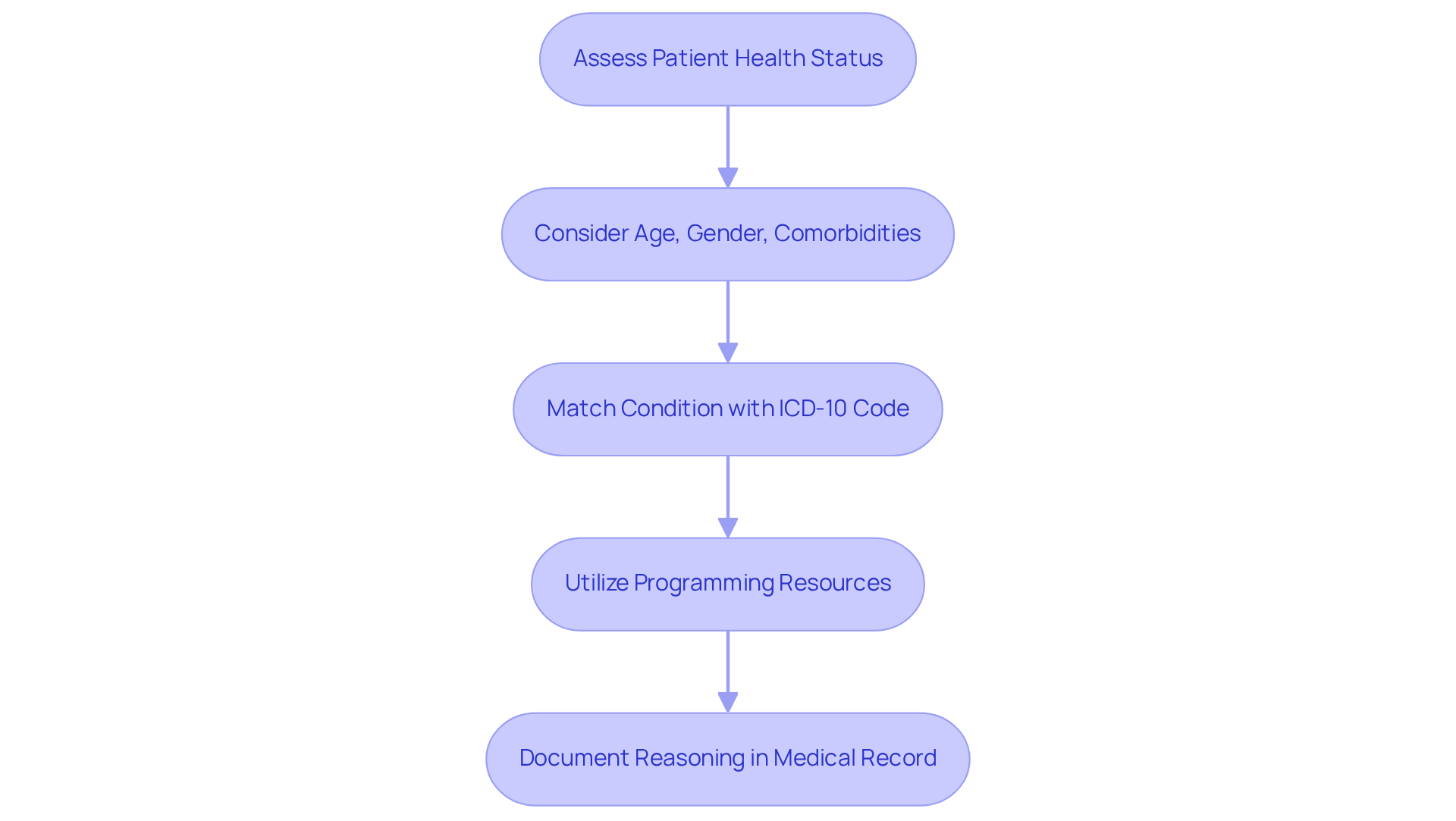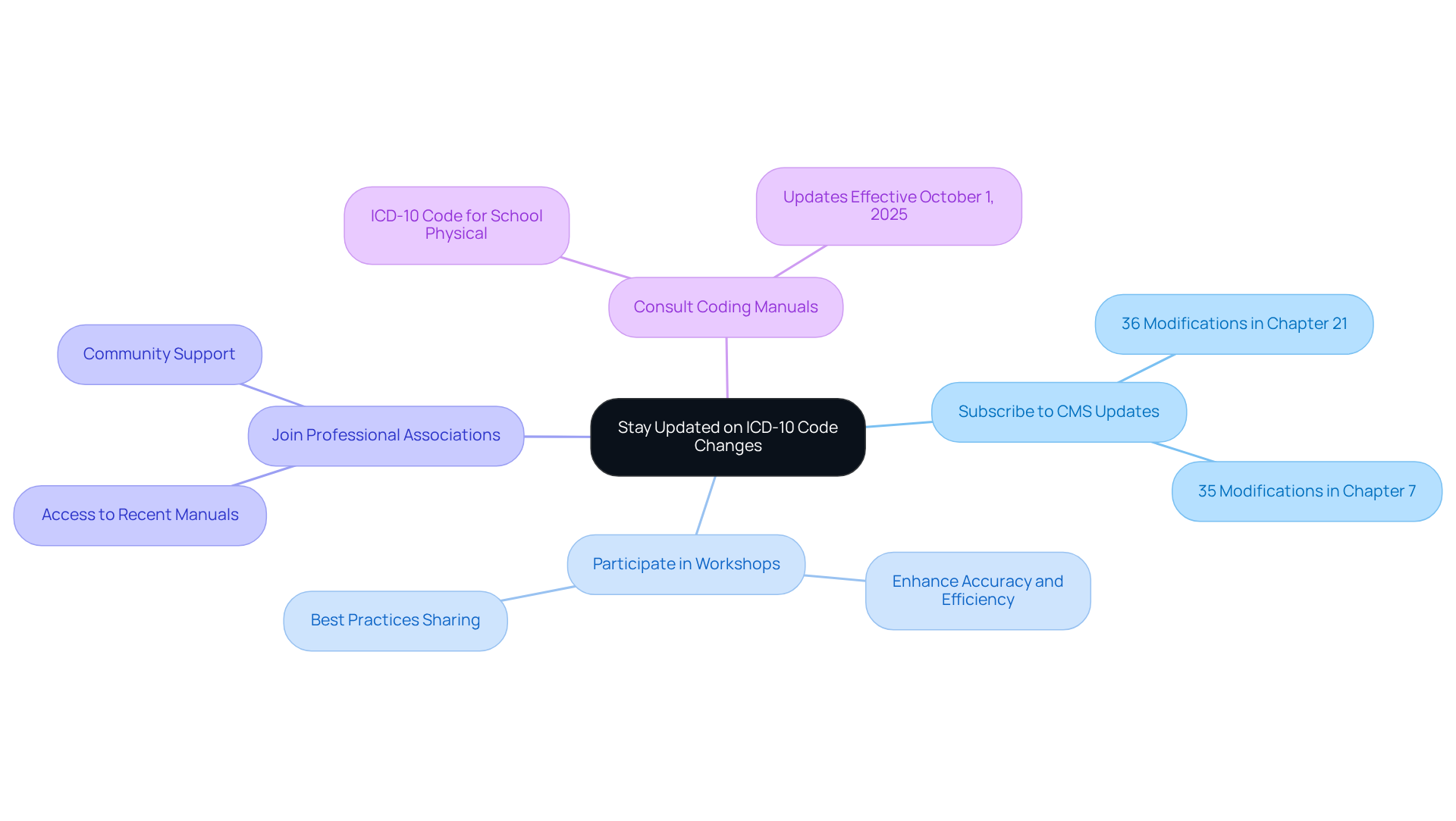Overview
Navigating the complexities of school physicals can be challenging for healthcare providers. The ICD-10 code is essential for accurate documentation and compliance. Common codes such as Z02.0 for routine health examinations and Z02.5 for sports participation play a crucial role in this process. Have you ever faced the frustration of claim denials due to coding errors? Selecting precise codes is vital to prevent such issues and ensure proper reimbursement.
Thorough documentation, including medical history and immunization records, is not just a formality; it’s critical for meeting regulatory requirements and supporting patient care. By focusing on these details, you can alleviate some of the administrative burdens that often detract from direct patient interaction. Remember, every piece of information contributes to a more complete picture of your patient's health.
As you reflect on your coding practices, consider how these strategies can enhance your workflow. Embracing accurate coding not only safeguards your practice but also supports the well-being of your patients. Together, we can ensure that every student receives the care they deserve, free from the stress of administrative hurdles. Let's commit to excellence in our documentation and coding practices, paving the way for better healthcare outcomes.
Introduction
Navigating the intricate world of ICD-10 coding for school physicals can feel overwhelming for healthcare providers. It's essential to ensure compliance and maximize reimbursement, but the emotional toll of administrative burdens can weigh heavily on your ability to provide patient care. This article serves as a comprehensive checklist, offering insights into the vital codes and documentation practices required for accurate assessments.
With frequent updates and the potential for claim denials looming, how can you stay ahead of the curve and avoid pitfalls in your coding practices? Together, we can explore solutions that not only ease your workload but also enhance the quality of care you provide.
Understand ICD-10 Codes for School Physicals
- Understanding the organization of the classification system is essential. It is structured into categories and subcategories, each containing specific identifiers that clarify various diagnoses and procedures. How familiar are you with these classifications?
- The role of diagnosis and procedure identifiers is crucial in documenting assessments from physical examinations. Accurate classification not only supports adherence but also maximizes reimbursement. Have you considered the implications of omitting the exam's purpose? This can lead to incorrect coding, regulatory non-compliance, and even claim denials.
- The common ICD-10 code for school physical includes Z02.0 (Encounter for routine child health examination required for school admission) and Z02.5 (Encounter for examination for participation in sports). Variants such as Z00.121 for encounters with abnormal findings and Z00.129 for those without are also important to know. Are these codes familiar to you?
- Choosing the most precise identifier available is vital to accurately represent a patient's condition. This choice can significantly and regulatory compliance. Additionally, consider using extra identifiers alongside primary diagnosis numbers when relevant, such as R94.6 for abnormal findings. How might this practice benefit your documentation?
- It's essential to use the ICD-10 code for school physical, like Z02.0 for admission assessments, to prevent claim denials and ensure proper documentation of the exam's purpose. This practice is key for compliance and reimbursement. With the 2025 ICD-10 updates introducing new codes, are you prepared to integrate these changes into your documentation?

Verify Documentation Requirements for School Physicals
It's essential to ensure that the physical form from the institution is not only filled out but also endorsed by the provider. This step is crucial in fostering trust and clarity in the patient-provider relationship.
Additionally, documenting all relevant patient information, including medical history and current medications, is vital. This thoroughness helps in understanding the patient's unique needs and addressing any concerns they may have.
Don't forget to verify that any required immunization records are included with the physical examination documentation. This inclusion is important for compliance and the well-being of the patient.
Lastly, be mindful of any specific school or state requirements that may necessitate additional documentation. Understanding these needs can , ensuring a smoother process for everyone involved.

Select Appropriate ICD-10 Codes for Each Scenario
Assessing a patient's health status can be a challenging yet crucial part of care. As you conduct the physical examination, consider any specific concerns that may arise. How can we ensure that every detail is captured with compassion and accuracy?
It is essential to match the patient's condition with the appropriate ICD 10 code for school physical classification. Remember to consider factors such as age, gender, and any comorbidities. This thoughtful approach not only aids in precise coding but also reflects our commitment to understanding each patient's unique situation.
Utilizing can significantly assist in selecting the most precise identifiers for each scenario. These tools are designed to lighten the administrative load, allowing you to focus more on what truly matters—your patients.
Finally, documenting the reasoning for chosen identifiers in the patient's medical record is vital. This practice supports billing and future care decisions, ensuring that every patient's journey is well-documented and understood. Together, let’s strive for a seamless integration of care and administration, fostering an environment where patients feel valued and understood.

Stay Updated on ICD-10 Code Changes and Guidelines
Subscribe to updates from the Centers for Medicare & Medicaid Services (CMS) to receive timely information on ICD-10 code alterations. This is crucial for ensuring compliance with the latest standards, especially with the significant changes of 36 modifications in Chapter 21 and 35 in Chapter 7 for 2024. Staying informed can alleviate some of the stress associated with these updates.
Participate in workshops and webinars that focus on programming updates and best practices. These sessions can significantly enhance your accuracy and efficiency. As Janet Scott, an experienced expert in the medical billing field, emphasizes, "Staying informed on compliance with classifications is essential for enhancing financial performance." This knowledge can empower you to .
Join professional associations that offer vital resources and support for healthcare providers in billing practices. Access to the most recent manuals and guidelines can make a world of difference in your daily operations. It’s about creating a supportive community that understands your challenges.
Regularly consult coding manuals and guidelines, especially for the ICD-10 code for school physical, to maintain adherence to the most current coding standards and practices. This is particularly important with the upcoming ICD-10-CM code updates effective October 1, 2025. By staying proactive, you can ensure that you are well-prepared and confident in your coding practices.

Conclusion
Understanding and utilizing the correct ICD-10 codes for school physicals is essential for healthcare providers who genuinely care about their patients. Accurate coding not only ensures compliance with regulatory standards but also significantly impacts the ability to receive fair reimbursement. It’s vital to familiarize yourself with specific codes like Z02.0 and Z02.5, along with thorough documentation to support these codes during billing processes.
Consider the importance of meticulous documentation of patient information, including medical history and immunization records. Staying informed about updates to the ICD-10 coding system can alleviate some of the stress associated with these responsibilities. Engaging with resources such as:
- Workshops
- Professional associations
- Coding manuals
can greatly enhance your ability to navigate the complexities of coding. By choosing precise identifiers and understanding the implications of your coding choices, you reinforce the significance of diligence in this critical area.
Ultimately, staying updated on ICD-10 code changes and guidelines is not merely a regulatory requirement; it reflects a commitment to delivering high-quality care. By prioritizing accurate coding and thorough documentation, healthcare providers can reduce stress for themselves and their patients, ensuring a smoother process for school physicals. Embracing these best practices fosters an environment where compliance and patient care can flourish, benefiting the entire healthcare system. Remember, your dedication to these practices makes a difference in the lives of your patients.




